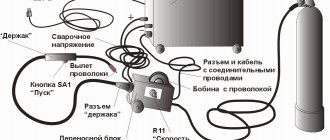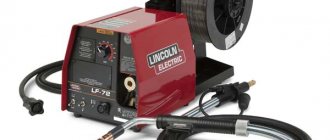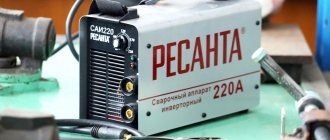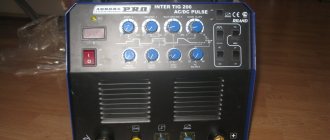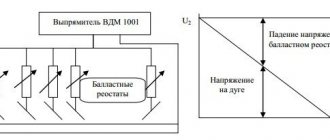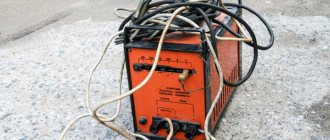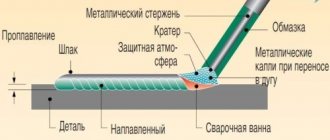It is difficult to imagine high-quality production of metal products without the use of welding. Semi-automatic welding is one of the most common methods used for welding ferrous and non-ferrous metals of various thicknesses.
The use of special technologies in semi-automatic welding can significantly improve the quality of the weld and speed up the process. This type of welding is actively used at many car service stations to perform body repairs.
What is semi-automatic welding?
Before you start mastering the technology of semi-automatic welding, you should know the structure of the equipment.
The electromechanical tool, called semi-automatic welding, includes:
- the main unit responsible for supplying power and electrode wire;
- welding sleeve or hose;
- a burner with a wire inside;
- conductive tip;
- shielding gas supply system.
Some large enterprises use semi-automatic stationary models that provide fast welding speed, uniform seams and low electrical energy consumption.
Semi-automatic welding machine.
All types of semi-automatic machines according to the method of operation are divided into:
- equipment for welding in an inert gas environment;
- a device that uses flux for the base;
- devices using cored wire;
- universal semi-automatic machines.
All types of semi-automatic welding machines are ideal for performing work on joining products made of non-ferrous or ferrous metal.
According to the method of feeding electrode wire, semi-automatic welding machines are divided into:
- Stationary. The equipment is rigidly fixed on a stand or a special console.
- Portable. The device is made in the form of a portable cabinet.
- Mobile. A special trolley adapted for moving around one room.
Based on the location of the feed rollers, semi-automatic machines can be divided into:
- pushing;
- pulling;
- push-pull.
How to "gas"?
Acetylene is still widely used today where small amounts of welding are needed, especially in emergency situations. Other flammable gases are also widely used: hydrogen and natural gas, propane (separately and mixed with butane) and petroleum, as well as gasoline and kerosene vapors.
But ethin is the king among them in terms of calorific value and thermal properties of the torch (this can be seen in the photo of gas welding) in its mixture with O2. And it is used more than other gases for these purposes.
Pros and cons of technology:
- no power supply required;
- inexpensive equipment and accessories;
- is carried out only manually;
- Not high quality of products in terms of mechanics and durability.
Features of the technology
Semi-automatic welding allows you to weld even rusty or galvanized metal with high quality. When connecting products made from materials that are difficult to weld, it is best to use copper or aluminum wire, since these metals allow you to obtain a strong and uniform seam.
In general, gas shielded or flux welding technology includes the following preparatory steps:
- cleaning and degreasing surfaces to be welded using popular solvents;
- checking gas equipment;
- performing a test seam to adjust the welding equipment settings;
- fine selection of current and voltage.
Welding in a shielding gas environment is the simplest option for using the equipment. Any gas is suitable for semi-automatic welding: carbon dioxide, helium, nitrogen or argon. The welding technique is the same for all gases.
Most often, novice welders choose carbon dioxide for welding due to its low cost and fairly good parameters.
Advantages of semi-automatic welding in a carbon dioxide environment:
- maintaining the appearance of the product;
- the ability to process even the most difficult to reach areas;
- minimum amount of waste;
- strong and thin weld seam;
- fast speed of work.
Welding in a carbon dioxide environment is one of the simplest methods of joining metal products.
Selecting current for semi-automatic welding.
The quality of the weld may depend on the following subtleties:
- wire guiding method;
- maintaining the required interval between connected parts;
- failure to comply with work standards.
Welding with semi-automatic equipment without gas is an alternative option for joining metals, which allows you to prevent the occurrence of oxides and control the production of a high-quality seam.
The gasless welding method involves the use of direct current supply and the use of flux-cored or flux-cored wire. During the welding process, when the wire burns, a gaseous environment is formed that is sufficient for high-quality work.
Connecting steel products using gasless semi-automatic welding is divided into stages:
- purchase of welding steel wire with flux;
- turning on the wire feed;
- turn the switch to the on position;
- placing flux inside the funnel;
- opening the protective flap to release flux;
- starting the device with the start button;
- waiting for the appearance of an electric arc;
- direct execution of work.
It is important to note that semi-automatic welding devices allow you to weld even aluminum parts with non-standard characteristics. To connect aluminum products, it is necessary to use argon as a shielding gas.
Due to the presence of an inert atmosphere, the aluminum oxide film, after its destruction, cannot appear again and nothing will interfere with the work being done quietly.
Preparatory work
Before welding, the parts must be completely cleaned of dirt and oxides. This is the basis for both a high-quality seam and the further preservation of the body in this place.
The method of connecting parts is selected. Thanks to the semi-automatic machine, this is not critical; you can easily weld parts end-to-end or with overlap in any spatial position. The apparatus is being prepared. The nozzle is cleaned or replaced, wire and carbon dioxide reserves are checked.
On test pieces of similar metal, the modes, current, supply and pressure (flow) of gas are set. The strength of the test connection is checked.
Setting up the welding machine
High-quality semi-automatic welding for beginners cannot do without fine-tuning the equipment.
Before using the device, the welder must install:
- current strength;
- wire feed speed;
- required shielding gas pressure.
Most semi-automatic welding machines are supplied with accompanying documentation containing optimal settings for certain operating modes. There are parameters that should be used as a starting point when fine-tuning the equipment.
You can check the correct settings of the parameters on separate unnecessary pieces of metal. To set the correct parameters when working in a protective gas environment, it is necessary to ensure that the weld is smooth and uniform, without drips or interruptions.
The optimal working gas pressure should generally be between 1-2 atmospheres.
Preparing the semiautomatic device for operation includes the following steps:
- Selecting the optimal wire radius. Most of these consumables come with a radius from 0.03 to 0.06 centimeters. The best choice for most materials is a wire radius of 0.04 centimeters.
- Pulling the wire until it exits the torch and adjusting the degree of its pressure.
- Preparation of optimal shielding gas. The two most commonly used gases are carbon dioxide and argon. The first option is cheap, common and great for welding steel parts. Argon is a more expensive shielding gas that ensures high stability of the electric arc and reduces the amount of metal splashes during work.
- Connecting the gas cylinder to the equipment.
Semi-automatic welding in a protective gas environment.
When setting up the equipment, you must adhere to certain rules that allow, if you have certain skills, to obtain an even and high-quality seam:
- ensuring uniform arc burning;
- installation of electrode wire forward direction;
- cleaning seams from accumulated slag.
The most optimal equipment settings are indicated in the accompanying documentation for the welding installation. However, you should not always completely trust the factory parameters.
Thus, the operating properties of the device can be affected by:
- various operating modes;
- quality of the electrical network;
- composition of the alloy being joined;
- ambient temperature;
- thickness and composition of filler wire;
- spatial positions of work;
- composition of the shielding gas.
The most common errors when setting up welding equipment are:
- Loud extraneous sounds resembling crackling. Similar symptoms can occur if the solder supply speed is insufficient. To avoid such misunderstandings, the feed rate of filler materials should be increased.
- Heavy splashing of metal droplets. The malfunction occurs when there is insufficient shielding gas. The problem can be resolved by checking the reducer or increasing the power of the gas flow.
- Poor penetration and low quality seam. Fault due to incorrect voltage and inductance settings.
- Uneven roller width. The defect may occur due to incorrect choice of burner speed.
Equipment used
The set of equipment for gas welding includes:
- Water seal to prevent damage to equipment components from backfire. Installed between the burner and the acetylene source. As evaporation occurs, water is added.
- Oxygen and flammable gas cylinders or acetylene generator. According to safety regulations, the gas should not come into contact with the paint. Therefore, the top of the cylinders is not painted. To prevent an explosion when acetylene comes into contact with copper, valves made of a different metal must be installed on cylinders with this gas.
- Gas burner, regular or injection.
- Reducers to reduce the pressure of gas and oxygen at the outlet of the cylinders.
- Hoses for connecting the gas burner to cylinders. Hoses for flammable gases have a yellow stripe.
Gas welding equipment
If gas welding work is carried out in different places, the equipment is installed on a trolley with appropriate fastenings. Enterprises install stationary gas stations with ventilation and cabinets for storing cylinders.
Types of welds in semi-automatic welding
Semi-automatic welding technology allows you to obtain different types of seams, depending on the equipment settings.
According to the type of connection, seams produced by semi-automatic machines are divided into:
- butt;
- T-bars;
- overlap;
- corner.
Features of semi-automatic welding.
According to their spatial position, welds are usually divided into:
- horizontal;
- vertical;
- ceiling;
- lower ones.
Popular ceiling seams are usually made in two stages:
- Welding the root seam. The preparatory seam is usually performed with three-millimeter electrodes with low current.
- Full completion of the seam.
The second welding stage of the ceiling seam can be performed in two ways:
- Welding using short, jerky seams or spot welding. This welding method prevents drops of molten metal from falling on the operator. When performing such a procedure, additional welding may be required at the beginning and end of the seam.
- Cooking with the shortest possible arc. This approach will allow the metal to quickly harden, immediately after the electric flame is removed.
Bottom connections, made using semi-automatic or manual arc welding, are often used in factories and industries. Such welds provide high mechanical characteristics due to the uniform distribution of molten metal.
Semi-automatic welding modes when making corner joints can be different.
Table of characteristics of semi-automatic welding machine.
Semi-automatic gas welding of corner metal structures can be performed:
- With a perpendicular arrangement of two workpieces. This technique allows you to weld only the internal joint. Cooking perpendicularly located tubes should include making a concentric weld around the circumference.
- With an angle of less than 60 degrees between the parts being welded. The best option for performing a fillet weld. In this case, the workpieces are completely boiled.
The butt weld is the most popular method of joining pipelines or steel sheets.
This type of welding is divided into:
- one-sided welding;
- one-sided welding and processing;
- double-sided welding.
One-sided welding in shielding gases is used for product thicknesses of no more than 4 millimeters. If the parts have a thickness of more than 8 millimeters, it is necessary to perform double-sided welding.
The best method for ensuring high strength of a thick product when welding one side is to groove the edges. The cutting is carried out using a grinder or a file. During the processing of the joined ends, a bevel of 45 degrees is formed.
An overlap joint is usually performed to ensure high tensile strength of the product. The seam should be made on both sides of the contacting surfaces to avoid moisture accumulation.
A T-joint is in most cases used to secure the base of a metal structure. When the metal thickness is more than 4 millimeters, it is recommended to use a double-sided weld.
Vertical
The technology of semi-automatic welding of a vertical seam has several important principles:
- Molten drops of metal should solidify faster than with conventional welding. This condition is necessary due to the gradual flow of molten metal downward under the influence of universal gravity. The required droplet size can be ensured only by reducing the size of the welding arc.
- Vertical welding is done from bottom to top. The welding method ensures the absence of sagging and unevenness when making a vertical seam.
There are several rules that can be followed to guarantee a high-quality vertical connection when welding from top to bottom:
- use of a short arc;
- perpendicular position of the electrode at the beginning of welding;
- the location of the electrode at an acute angle relative to the weld seam.
Welding wire feeder.
Although such steps make it possible to obtain a vertical seam by welding semi-automatically from top to bottom, as the lessons learned by experienced welders show, such joints have much more meager characteristics.
There are three technologies for welding vertical seams using semi-automatic machines:
- Triangle. It is used when connecting parts with a thickness of less than 2 millimeters. The essence of the method is as follows: during the operation of the welding arc, liquid metal flows from bottom to top onto the already solidified metal. In this case, the flowing slag moves at a certain angle, depicting a triangle.
- Herringbone. Method used to join 2-3mm gaps. Welding begins from the plane of one of the edges. Then, using an electrode, the metal is melted throughout the entire thickness of the workpiece, after which the arc is drawn to the very depth of the gap.
- Ladder. The best option for eliminating large gaps between parts. The method involves performing welding work using a zigzag movement of electrodes from edge to edge.
Horizontal
Semi-automatic welding allows you to perform high-quality horizontal seams. Performing such operations is not much different from creating vertical connections. The welding process can be performed both from right to left and from left to right.
You can get a high-quality horizontal seam by taking into account these subtleties:
- the arc burning force must be equal to the gravity force of the metal drops;
- the speed of movement of the electrode must be selected separately for a horizontal seam;
- Welding work should be carried out continuously in order to keep the melt under control.
Arc welding sometimes makes it impossible to complete a seam in one go. In this case, you can use the welding technique with periodic arc extinguishing. When metal thickness is up to 4 millimeters, the use of various welding patterns is allowed.
Otherwise, the quality of making a horizontal connection using semi-automatic or manual equipment completely depends on the skill of the welder.
Semi-automatic welding machine.
The process of creating a horizontal welding seam can be divided into four stages:
- Creating a root roll. The root weld bead is made with a short electric arc. The angle of inclination of the electrode to the surface should be about 80 degrees. The primary roller, as a rule, is created with the maximum current allowed for the equipment.
- Formation of the secondary roller. The process begins with setting the average current strength. The secondary roller is made in one pass, in which it is advisable to use an electrode with a large diameter. The second welding bead should be formed using the forward angle technology.
- Getting the third roller. The tertiary bead can be created in two ways, depending on the success of the previous stage. If the secondary roller has a large area, then the third should lie exactly in the center. If the second roller turned out to be standard, then the third stage is performed in two approaches.
- Final welding of parts.
During the work process, you should carefully monitor the upper part of the seam being formed, since it is in this area that various welding defects appear.
Welding thin and thick metal
The nature of semi-automatic welding depends on the type of product being welded.
The connection of thin metal, depending on the type of product, is made in two ways:
- Regular sheet metal can be welded by any method.
- Riveted thin metal should be overlapped and welded through pre-prepared holes in the top sheet.
Electrical circuit of a semi-automatic machine.
When welding thin metal products, you need to remember the following subtleties:
- the current, voltage and wire exit speed must be adjusted downward;
- It is forbidden to hold the electric arc in one place, as this may result in burning of the product or influx of the welding bead;
- It is important to weld thin rivet metal starting from the center of the lower workpiece in order to avoid flooding of the prepared holes.
If the weld does not need to be airtight, spot welding can be done at intervals of 1 to 5 centimeters.
Thick metal with a wall thickness of more than 4 millimeters is joined by chamfering the surfaces to be welded. Such preparation allows you to obtain an even seam and qualitatively boil the workpieces.
Welding work with thick metals should be carried out using small oscillating movements of the torch. The table of welding modes that comes with each semi-automatic machine contains extensive information about the optimal parameters for welding thick metal products.
Basic rules for connecting thick metal products:
- the gap between the parts should be no more than 2 millimeters;
- the width of the weld should be equal to the thickness of the workpiece;
- The choice of welding materials should be made depending on the metals being joined.
If the task is to thoroughly weld metal products with a width of more than 5 millimeters, then the work should be done in several approaches. First, you need to create a welded joint in the center of the workpiece, and in the second and third approaches you can weld the parts from above and below.
Welding work is recommended to be performed outdoors or in a well-ventilated area.
Gas welding - a universal solution
It is difficult to find an industry where gas welding is used - a method of firmly joining metals to each other in the melting stage with a flame of special temperatures. After all, acetylene burns at 3,200-3,400 degrees.
Gas welding technology is simple. This method can replace electric arc, but gas cannot. But still, the first one has priority on thin metals. The arc will simply melt them, as in open-hearth, and not hold them together.
Features of wire welding
Features of welding with wire using semi-automatic equipment are as follows:
- the filler material must correspond to the chemical composition of the product being welded;
- the wire must meet government standards and be made from the correct components;
- The terms and conditions for storing filler wire must be strictly observed.
A review of the features of work using filler wire should begin with welding basics. Most metals welded in production or at home are steel and manganese. Wire for connecting such products is the most in demand.
Welding of ferrous metals is usually carried out using the following types of filler material:
- Wire Sv-08GS for joining low-carbon and alloy steels.
- Wire Sv-08G2s for welding high-carbon steel.
Flux-cored wire is often used for welding ferrous metal products. This filler material allows welding to be carried out without additional gas supply to the welding zone.
Self-fluxing wire is a low-carbon steel tube with a powder core. When the metal melts, powder is released, forming a gaseous environment to protect the weld. As a rule, the fluxing powder contains rutile and metal dust.
Stainless steel is welded with wire grades Sv.-06Х19Н9Т, Sv.-04Х18Н9 or Sv.-01Х19Н9. This filler wire provides good mechanical and physical properties of the weld.
The connection of aluminum parts is carried out using SV-AK5 wire. A characteristic feature of this filler material is the unique color of the weld. Immediately before joining aluminum products, preparation should be carried out.
Semi-automatic welding using flux-cored wire.
This procedure is divided into steps:
- Creating bevels or chamfers.
- Mechanical cleaning of surfaces.
- Washing with caustic substances to slow down the formation of a refractory oxide film on the surface of an aluminum product.
- Preparation of a Teflon channel to reduce friction of the filler wire on the walls of a semi-automatic welding device.
Step-by-step instructions for using carbon dioxide welding for beginners include the following subparagraphs:
- removing all foreign objects from the workplace;
- turning on maximum lighting;
- preparation of material and tools;
- checking cable connections and functionality of extension cords.
After completing the above points, you should proceed to preparing the electric arc welding machine.
To do this you need:
- unwind the welding sleeve;
- connect the gas cylinder;
- check the burner nozzle;
- conveniently place all the parts to be connected and fasten them securely;
- dress in welder's work clothes;
- connect semi-automatic equipment to the network;
- bring the torch to the intended connection site.
Upon completion of welding work using wire, you should:
- remove your fingers from the wire feed buttons;
- shut off the gas supply;
- turn off the power to the equipment;
- Allow the seam to cool for several minutes;
- If defects are found, repeat welding.
The semi-automatic welding machine allows you to use all types of filler wire.
When performing work, it is important not to forget about protective equipment.
Semiautomatic welding machine with thyristor control.
The most complete welder equipment consists of:
- Eye protection. The ideal equipment to protect a welder's vision is a mask, face shields and goggles.
- Respiratory protection. Special filter masks will help the master to significantly reduce the impact of harmful fumes on internal organs.
- Splash protection. Full body protection should include a flame retardant jacket and trousers. You can use overalls.
Safety precautions when performing welding work include the following rules:
- Carrying out work from wooden scaffolding. The use of metal protective masks and helmets is prohibited.
- Providing light flux from a 12 volt power source.
- Providing insurance for the welder using a string attached to the belt. The rope size must be at least 2 meters.
- Providing the workplace with a special hood that ensures the removal of harmful fumes from the work area. In cases where it is impossible to provide exhaust, the welder must work in a hose gas mask or respirator.
- Do not touch the workpiece to be welded with bare hands.
- It is prohibited to carry out work in open areas during precipitation.
What alloy steels can be welded semi-automatically
Stainless steel means a metal that can resist corrosion. For this purpose, it contains alloying additives in the form of chromium, nickel, manganese, and molybdenum. There are low-alloy, medium-alloy and high-alloy metals. A semi-automatic machine can weld all types, but only under certain conditions.
Low-alloy steels (alloying element content 3-5%) and medium-alloy steels (5-10%) are welded “cold”, i.e. You can attach the blanks and immediately cook with a semi-automatic device. High-alloy metals (additive content more than 10%) can be welded in the same way, but it is better to use preheating to 300-400º C. This category of stainless steels is called austenitic (high content of chromium and nickel), it welds perfectly at any thickness and resists corrosion for a long time if choose the right welding wire.
